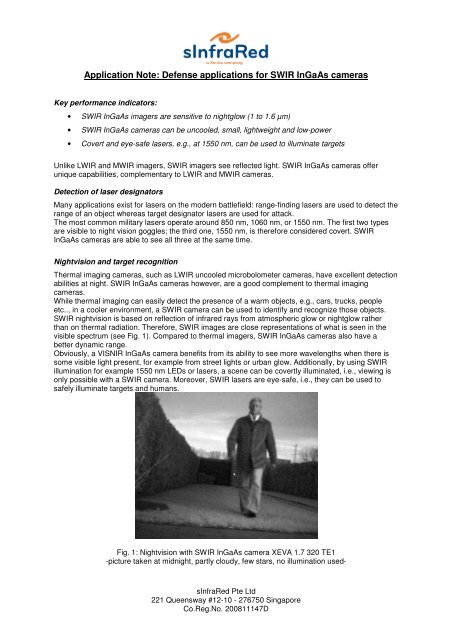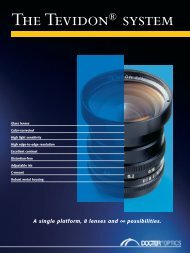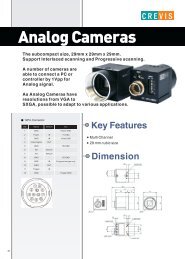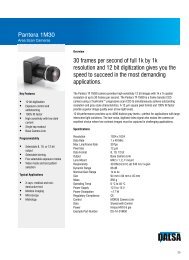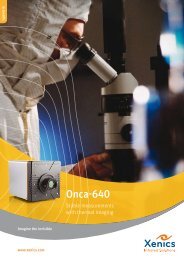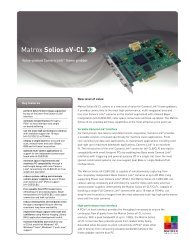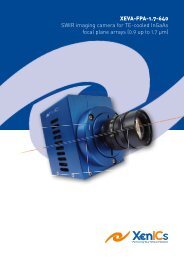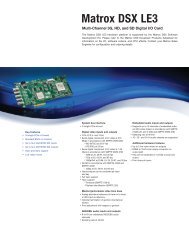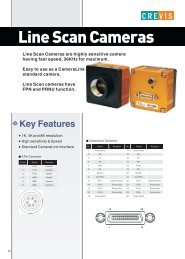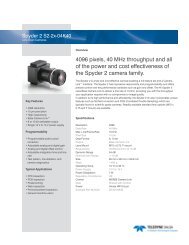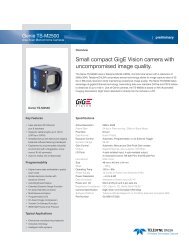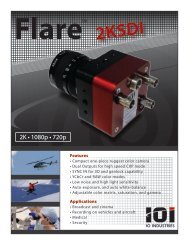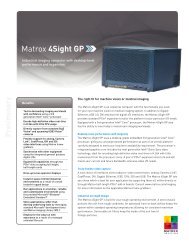Application Note: Defense applications for SWIR ... - Machine Vision
Application Note: Defense applications for SWIR ... - Machine Vision
Application Note: Defense applications for SWIR ... - Machine Vision
You also want an ePaper? Increase the reach of your titles
YUMPU automatically turns print PDFs into web optimized ePapers that Google loves.
<strong>Application</strong> <strong>Note</strong>: <strong>Defense</strong> <strong>applications</strong> <strong>for</strong> <strong>SWIR</strong> InGaAs cameras<br />
Key per<strong>for</strong>mance indicators:<br />
• <strong>SWIR</strong> InGaAs imagers are sensitive to nightglow (1 to 1.6 µm)<br />
• <strong>SWIR</strong> InGaAs cameras can be uncooled, small, lightweight and low-power<br />
• Covert and eye-safe lasers, e.g., at 1550 nm, can be used to illuminate targets<br />
Unlike LWIR and MWIR imagers, <strong>SWIR</strong> imagers see reflected light. <strong>SWIR</strong> InGaAs cameras offer<br />
unique capabilities, complementary to LWIR and MWIR cameras.<br />
Detection of laser designators<br />
Many <strong>applications</strong> exist <strong>for</strong> lasers on the modern battlefield: range-finding lasers are used to detect the<br />
range of an object whereas target designator lasers are used <strong>for</strong> attack.<br />
The most common military lasers operate around 850 nm, 1060 nm, or 1550 nm. The first two types<br />
are visible to night vision goggles; the third one, 1550 nm, is there<strong>for</strong>e considered covert. <strong>SWIR</strong><br />
InGaAs cameras are able to see all three at the same time.<br />
Nightvision and target recognition<br />
Thermal imaging cameras, such as LWIR uncooled microbolometer cameras, have excellent detection<br />
abilities at night. <strong>SWIR</strong> InGaAs cameras however, are a good complement to thermal imaging<br />
cameras.<br />
While thermal imaging can easily detect the presence of a warm objects, e.g., cars, trucks, people<br />
etc.., in a cooler environment, a <strong>SWIR</strong> camera can be used to identify and recognize those objects.<br />
<strong>SWIR</strong> nightvision is based on reflection of infrared rays from atmospheric glow or nightglow rather<br />
than on thermal radiation. There<strong>for</strong>e, <strong>SWIR</strong> images are close representations of what is seen in the<br />
visible spectrum (see Fig. 1). Compared to thermal imagers, <strong>SWIR</strong> InGaAs cameras also have a<br />
better dynamic range.<br />
Obviously, a VISNIR InGaAs camera benefits from its ability to see more wavelengths when there is<br />
some visible light present, <strong>for</strong> example from street lights or urban glow. Additionally, by using <strong>SWIR</strong><br />
illumination <strong>for</strong> example 1550 nm LEDs or lasers, a scene can be covertly illuminated, i.e., viewing is<br />
only possible with a <strong>SWIR</strong> camera. Moreover, <strong>SWIR</strong> lasers are eye-safe, i.e., they can be used to<br />
safely illuminate targets and humans.<br />
Fig. 1: Nightvision with <strong>SWIR</strong> InGaAs camera XEVA 1.7 320 TE1<br />
-picture taken at midnight, partly cloudy, few stars, no illumination used-<br />
sInfraRed Pte Ltd<br />
221 Queensway #12-10 - 276750 Singapore<br />
Co.Reg.No. 200811147D
Laser gated imaging<br />
Laser gated imaging allows <strong>for</strong> imaging at long distances while reducing the effect of obscurants in the<br />
atmosphere. In laser gated imaging, a pulsed laser is used to illuminate the scene while the reflected<br />
light is detected by a camera with a short exposure or gating time. The exposure is delayed so<br />
imaging occurs at a particular distance, thus the image is only from the reflection of objects at that<br />
distance. When using a <strong>SWIR</strong> InGaAs camera, covert and eye-safe pulsed lasers can be used.<br />
Situational awareness – gunshot detection<br />
Acoustic sensors that “listen” to the shockwave of a bullet are not the only solution <strong>for</strong> gunshot<br />
detection. Gunshot signature can be identified, located and processed even faster using high-speed<br />
<strong>SWIR</strong> InGaAs cameras, either at night or during daytime. The combustion gases and hot debris<br />
projected from the gun upon firing are detectable.<br />
Seeing through haze, smoke and fog<br />
Compared to visible cameras, <strong>SWIR</strong> InGaAs cameras offer superior per<strong>for</strong>mance in imaging through<br />
dust, fog, haze or smoke (see Fig. 2). In case of fire, the location of the flames can easily be found.<br />
Visible image<br />
Fig. 2: Seeing through smoke<br />
<strong>SWIR</strong> InGaAs image<br />
Airborne reconnaissance, remote sensing and surveillance<br />
Small, low-power and lightweight <strong>SWIR</strong> InGaAs cameras can be used on airplanes and UAVs<br />
(unmanned air vehicles) <strong>for</strong> reconnaissance and surveillance missions. Hyperspectral <strong>SWIR</strong> cameras<br />
can be used to detect the unique spectral signature of militarily important items, <strong>for</strong> example<br />
camouflage material.<br />
sInfraRed Pte Ltd<br />
221 Queensway #12-10 - 276750 Singapore<br />
Co.Reg.No. 200811147D


